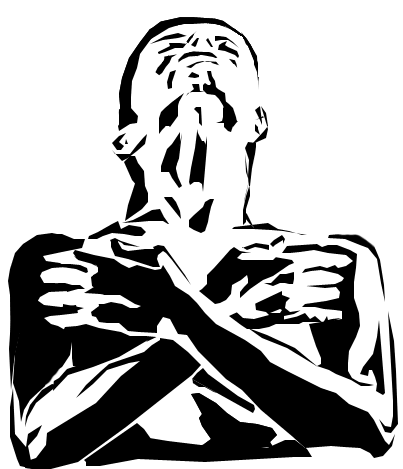Source: Close, A. "Emergency Care", 2001.
Unconsciousness
For a patient to be considered "Conscious", and therefore in complete control of their airway, three things need to be present:
- The eyes to open together and their movement controlled
- The ability to speak coherently and know who and where they are in time and place
- The ability to perform a task on command, such as squeezing the First Aider's hand.
Unconsciousness can be caused by many things:
1). Lack of Oxygen, due to:
a). Airway blockage by blood, food, vomit or drowning.
b). Breathing problems such as suffocation, asthma, smoke and gas inhalation
c). Circulation problems such as heart stopped or blood loss
2). Medical, due to diabetes, stroke, seizure, fainting, poisoning, or drug overdose.
3). Trauma, due to head injury, electric shock, snake bite, hyper or hypothermia.
A danger in unconscious patients is the loss of protective mechanisms, such as gagging, coughing, swallowing and moving. Therefore, an unconscious person on the floor may block their airway with their tongue, mucus, blood or food. The generalized loss of muscle control may also result in passive vomiting of the stomach contents (acidic matter). This happens when the stomach relaxes (opening the sphincter). The stomach contents flow the wrong way along the oesophagus (food pipe). The vomit can cover the airway and be drawn into the lungs. This is called aspiration and can cause serious lung damage or death. If the airway is not kept clear the patient will die.
Resuscitation
- The Lateral Recovery Position: is a simple but lifesaving manoeuvre that assists in clearing the airway by causing the jaw and tongue to fall forward. Blood, vomit and other fluid can then drain out, preventing blockage. Basically, you place the patient's arm across his chest to where he will turn, bend the knee on the same side and also push it across. Finally, you tilt the jaw and put the patient's arm beneath it to stabilize. Beware of any injuries that may counter-indicate movement as such.
- Airway Cleaning: to clean the airway (from food or other) use the "finger swipe" approach. Tilt the head back, support the lower jaw, and open the mouth. Look inside, and use finger sweeps (2 fingers) to clear objects from the front of the mouth. Leave dentures in place, unless broken or loose. Becareful the patient doesn't bite you.
- Breathing: Normal breathing occurs between 12 and 20 times per minute whilst at rest. Noisy breathing is a sign that the airway is no longer completely clear. Vomit, blood or other fluid can block the upper airway or can be inhaled (aspirated) into the lung.
Technique to check breathing: Place the palm of your hand on the patient's 'lower chest, upper stomach' area and your face close to the patient's mouth and nose. From this position:
a) Look for the rise and fall of the patient's chest
b) Listen for breathing sounds at the mouth and nose
c) Feel for the rise and fall of the patient's chest (diaphragm) with your hand; as well feel for the air exhaled from the patient's mouth and nose with the side of your face.
If the patient is either not breathing or not breathing adequately (only 6-8 times per minute, or very shallow - poor volume), the First Aider should commence Expired Air Resuscitation (EAR -see following blog)
If the patient's circulation has stopped (patient is unconscious, not breathing, pulseless, with blue skin and cyanosed, and the body looks limp and is not moving) start Cardio-Pulmonary Resuscitation (CPR - see following blog).
1/2/07
Subscribe to:
Post Comments (Atom)

No comments:
Post a Comment